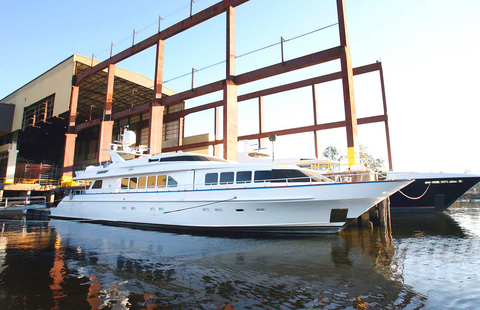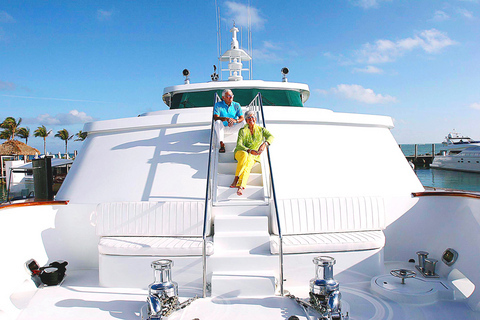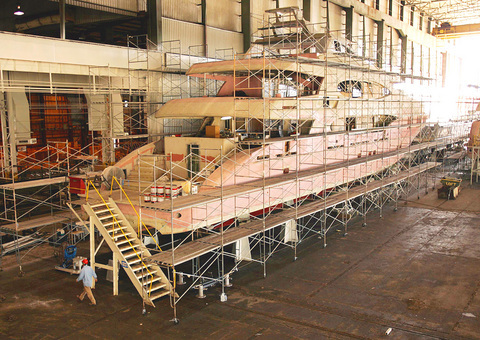Whether it's providing a helicopter pad or installing jade-inlaid marble in the master bedroom, William Smith III has grown accustomed to satisfying every request from his custom-yacht customers -- except when it comes to finding places where they can park their outsized boats.
Many mega-yachts have grown so big -- sometimes as long as a football field -- that their size rules out docking at most marinas, which do not have large enough slips to accommodate them. To combat the crunch, Smith, vice president of Trinity Yachts in Gulfport, Mississipi, one of the top custom yacht builders in the world, has begun to design vessels based strictly on where the owners plan to take them.
"If an owner tells me he wants to be in St. Bart's on New Year's Eve, that means he can't build over 200 feet (61m)," Smith said. "If they tell us they want to do the Bahamas, which is relatively shallow, the boat can't have more than an eight-foot (2.4m) draft -- no matter what size."

PHOTOS: NY TIMES NEWS SERVICE
Big and Better
More and more, limitations like these are frustrating the growing mega-yacht crowd. In recent years, the production of these nautical behemoths, which range from 24m to more than 61m and can easily cost as much as US$200
million, has been outpacing the availability of dockage long enough or deep enough to accommodate them.

PHOTO: NY TIMES NEWS SERVICE
There are an estimated 7,000 motor yachts over 24m long in use, said Jill Bobrow, editor in chief of ShowBoats International, a yachting magazine. That's up from about 4,000 a decade ago.
"Boats are getting bigger and bigger," Bobrow said. "It used to be that 200 feet (61m) was big. Now the largest boats are 400 feet (122m)." Contracts for motor yachts 46m and larger increased 15 percent, to 118 from 103, last year, according to ShowBoats International. Of those 118, 33 percent are more than 61m.
By contrast, there are roughly 440 marinas with berths big enough and water deep enough to accommodate vessels 30m or bigger, according to Superports, a British magazine that publishes an annual list of mega-yachts. It is a problem that has vexed Ira and Audrey Kaufman ever since they built their dream boat, Gray Mist III, a 46m yacht fashioned after their home in Illinois -- complete with antique furniture, a working fireplace and a dining table that seats 12 -- about five years ago.

"Many places that we go to, you can't get in the marina because our draft is too deep," said Kaufman, 77, a senior managing director. He ended up purchasing a dock slip at the Fisher Island Club, one of the few Miami-area marinas that can accommodate such a large boat. He estimates his dock slip would sell for about US$7,000 per 0.3m today.
Most marinas have only a handful of slips for these large vessels. And because boating is seasonal -- with owners typically heading to the Caribbean in the winter and the Mediterranean in the summer -- mega-yachts are constantly competing for the same dock space.
"There's so few marinas now that you can get a boat in," Kaufman said. "There's not room." Without a spot at the dock, mega-yacht owners and their passengers are relegated to dropping anchor off the coast and lowering a dinghy to get ashore. But after spending untold millions on a yacht and used to getting the VIP treatment everywhere else they go, most owners prefer not to do so.
"A lot of times, it's first come, first served," said Chris McChristian, who is working on his British captain's license. "If you get there and it's too tight, you'll go to a facility that's not as good or be at anchor somewhere having to commute in by tender. With owners, that's a very awkward position to be in." The mega-yachters, he added, "like to step on and off the boat."
But all that is about to change.
In an effort to capitalize on the megadollars that mega-yachts can bring to a harbor area, coastal resorts around the globe are racing to build or retrofit their marinas to accommodate the colossal cruisers. Nowhere is the pursuit more pronounced than in the Caribbean, where there are still large chunks of undeveloped shores, and in Florida, where a real estate boom over the last few years has been fueling new waterfront developments.
A haven found
From Miami to St. Thomas, new marinas with names like Super Yacht Harbor and Yacht Haven are being developed with berths for boats as long as 137m, roughly half the length of a 2,000-passenger cruise ship. To keep mega-yacht owners busy -- not to mention spending -- while their boats are parked at the marina, developers are surrounding their ports with high-end restaurants and retail shops. To entice yacht owners and their entourages to stay longer, they are also building luxury condominiums and five-star hotels.
As a result, a new real estate concept is beginning to emerge centered on the lifestyle of the boating elite. Island Capital Group in New York is transforming an existing port, Long Bay Harbor in St. Thomas, into a mega-yacht marina called Yacht Haven Grande with 48 slips averaging 30m in length. Twelve luxury condominiums, four waterfront restaurants, high-end shopping and a private yacht club around the 32-acre harbor are scheduled to open in the fall.
In Miami, Flagstone Property Group is designing Island Gardens, a US$480 million development to be built on Watson Island, between downtown Miami and South Beach. Island Gardens will include a 50-slip Super-Yacht Harbor for vessels up to 137m, a Westin hotel and a Shangri-La Hotel, to open in 2008, offering round-the-clock butler service.
Developers believe the mega-yachts will be an attraction, drawing other visitors to the destination as well. "It's not only a place to visit for the mega-yacht owners, but also a great opportunity for people to enjoy viewing the mega-yachts," said Mehmet Bayraktar, chief executive of Flagstone Property Group. "That's how places like Monaco and Portofino became famous. People want to get close to that lifestyle."
Bigwigs
Bigwig boaters who pull into these new marinas can expect white-glove treatment. Uniformed dockhands will greet owners upon arrival, help bring boats in and assist crews in obtaining provisions. The owner will be able to step off the boat for fine dining or a massage. A concierge office will be available to arrange car services or sightseeing excursions.
Many port towns see these new developments as a way to increase the flow of high-end tourists and help their economies with new jobs and revenue from servicing the big boats that stop by -- a 47m yacht can guzzle 16,000 gallons of gas at one fill up, for example -- as well as pampering their owners.
In 2002, the average expenditure of a mega-yacht visit to boatyards in Broward, Dade and Palm Beach counties in Florida was US$140,000, according to a report by Thomas Murray, a marine business specialist at the Virginia Institute of Marine Science at the College of William and Mary. The direct economic impact of mega-yacht repair and maintenance projects at local boatyards was an estimated US$181.6 million.

May 11 to May 18 The original Taichung Railway Station was long thought to have been completely razed. Opening on May 15, 1905, the one-story wooden structure soon outgrew its purpose and was replaced in 1917 by a grandiose, Western-style station. During construction on the third-generation station in 2017, workers discovered the service pit for the original station’s locomotive depot. A year later, a small wooden building on site was determined by historians to be the first stationmaster’s office, built around 1908. With these findings, the Taichung Railway Station Cultural Park now boasts that it has

The latest Formosa poll released at the end of last month shows confidence in President William Lai (賴清德) plunged 8.1 percent, while satisfaction with the Lai administration fared worse with a drop of 8.5 percent. Those lacking confidence in Lai jumped by 6 percent and dissatisfaction in his administration spiked up 6.7 percent. Confidence in Lai is still strong at 48.6 percent, compared to 43 percent lacking confidence — but this is his worst result overall since he took office. For the first time, dissatisfaction with his administration surpassed satisfaction, 47.3 to 47.1 percent. Though statistically a tie, for most

As Donald Trump’s executive order in March led to the shuttering of Voice of America (VOA) — the global broadcaster whose roots date back to the fight against Nazi propaganda — he quickly attracted support from figures not used to aligning themselves with any US administration. Trump had ordered the US Agency for Global Media, the federal agency that funds VOA and other groups promoting independent journalism overseas, to be “eliminated to the maximum extent consistent with applicable law.” The decision suddenly halted programming in 49 languages to more than 425 million people. In Moscow, Margarita Simonyan, the hardline editor-in-chief of the

Six weeks before I embarked on a research mission in Kyoto, I was sitting alone at a bar counter in Melbourne. Next to me, a woman was bragging loudly to a friend: She, too, was heading to Kyoto, I quickly discerned. Except her trip was in four months. And she’d just pulled an all-nighter booking restaurant reservations. As I snooped on the conversation, I broke out in a sweat, panicking because I’d yet to secure a single table. Then I remembered: Eating well in Japan is absolutely not something to lose sleep over. It’s true that the best-known institutions book up faster